An extraordinary astronomy event will occur in North America on April 8, 2024: a total solar eclipse that will be visible in parts of Mexico, the United States, and Canada. The eclipse’s path of totality — where the moon passes directly in front of the sun and daytime darkness descends on Earth — stretches from Mazatlan in Mexico on the Pacific Coast and across 13 states before reaching Canada’s Atlantic Coast.
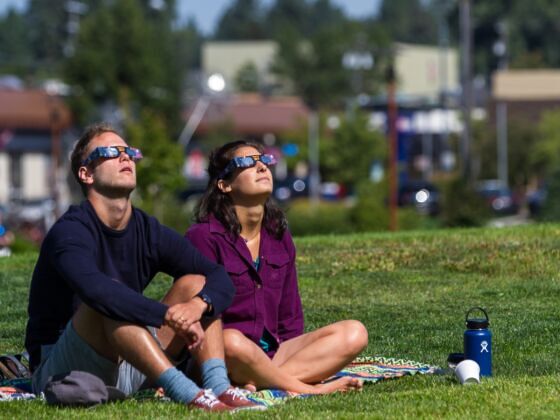

How and Where to Watch the 2024 Total Solar Eclipse
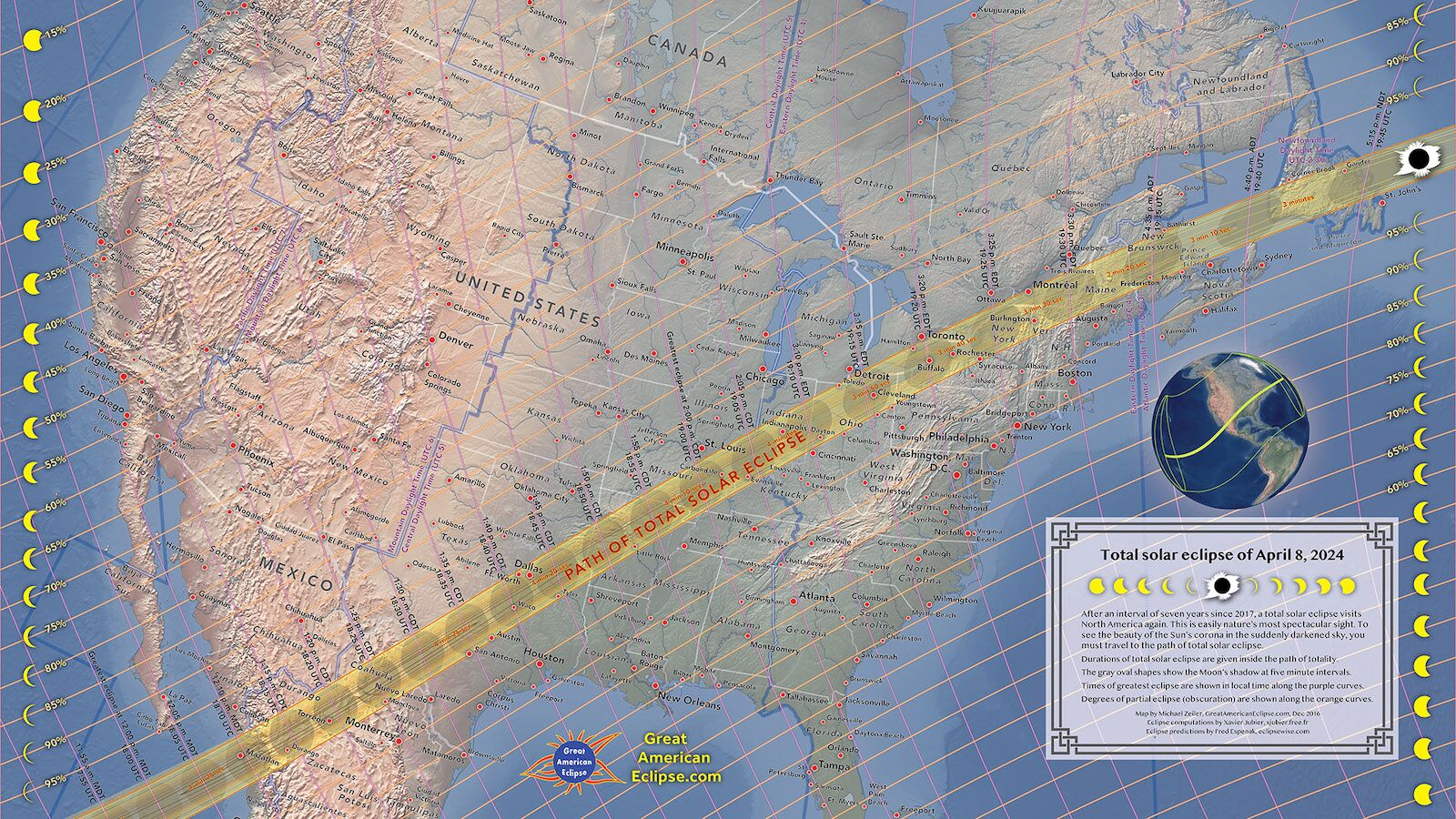
Photo: Great American Eclipse/Michael Zeiler
In the US alone, more than 31 million people live in the 115-mile-wide path of totality, according to Michael Zeiler, eclipse chaser, cartographer, and cofounder of the Great American Eclipse website. Millions more will travel to see the celestial phenomenon in its full glory. After all, the next time a total solar eclipse will be visible in North America is 2044 (and again with a larger swath sweeping through the US in 2045).
Here’s the scoop on where and when to watch the solar eclipse 2024 — and why you don’t want to miss this otherworldly sight.
Looking for a hotel on the path of the total solar eclipse? Check out Matador’s accommodations guides:
What it’s like to see a total solar eclipse
After viewing America’s total solar eclipse in August 2017, I vowed never again to miss one. It makes it easier that a solar eclipse is easy to travel to versus ones that happen in the middle of the ocean or the northern reaches of the globe.
Five years ago, I road-tripped with my husband and kids from our Colorado home to Wyoming on the path of totality. The weather gods were with us on a brilliantly sunny day when we caravaned with friends north of Cheyenne on I-25. We planned to stop at a roomy rest area, pull out our camp chairs, don our safe eclipse-viewing glasses, and wait for the late-morning sky show. Alas, thousands of other eclipse chasers had the same idea. Our intended parking spot was overflowing with traffic backed up to the interstate.
We ended up pulling off at a different exit ramp and positioning our chairs in an open field with others who’d been shut out of the rest area. The mood was upbeat and strangers were exceedingly cordial as everyone anticipated the big event. As the moon took an increasingly bigger bite out of the bright sun, the sky grew darker and the air temperature dropped a few degrees. The eerie phenomenon brought on lots of emotional “oohs” and “aahs.”
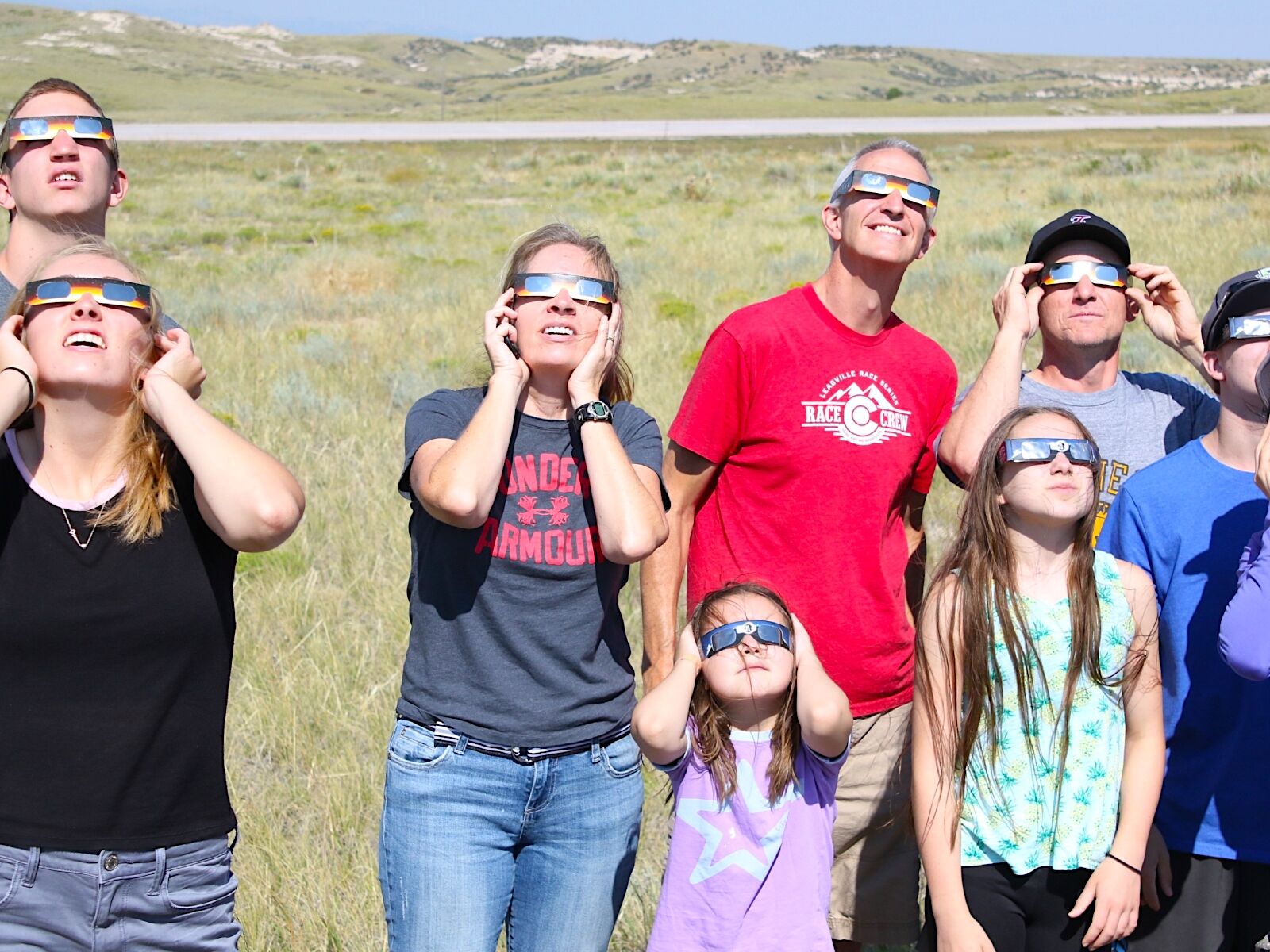
Photo: Kara Williams
When the sun was fully eclipsed, we took off our safety glasses for a couple of minutes to admire its corona: the sun’s ethereal, halo-like, outermost atmosphere that’s visible only during a total solar eclipse. The expansive Wyoming sky didn’t turn midnight black. Instead, a faint pink-orange glow dusted the 360-degree horizon, as if the sun were setting all around us.
The total eclipse happened so quickly that it was hard to know what to focus on: the sun, the sky, my camera (outfitted with a solar filter), or my family’s reaction. For the 2024 eclipse, I’ll eschew trying to take decent photographs to be more present. What I do recall: Tears welling in my eyes at the awe-inspiring shared experience. And my 17-year-old science-loving daughter whispering, “Thank you, Mother Nature.”
Where and when the total solar eclipse 2024 will be visible
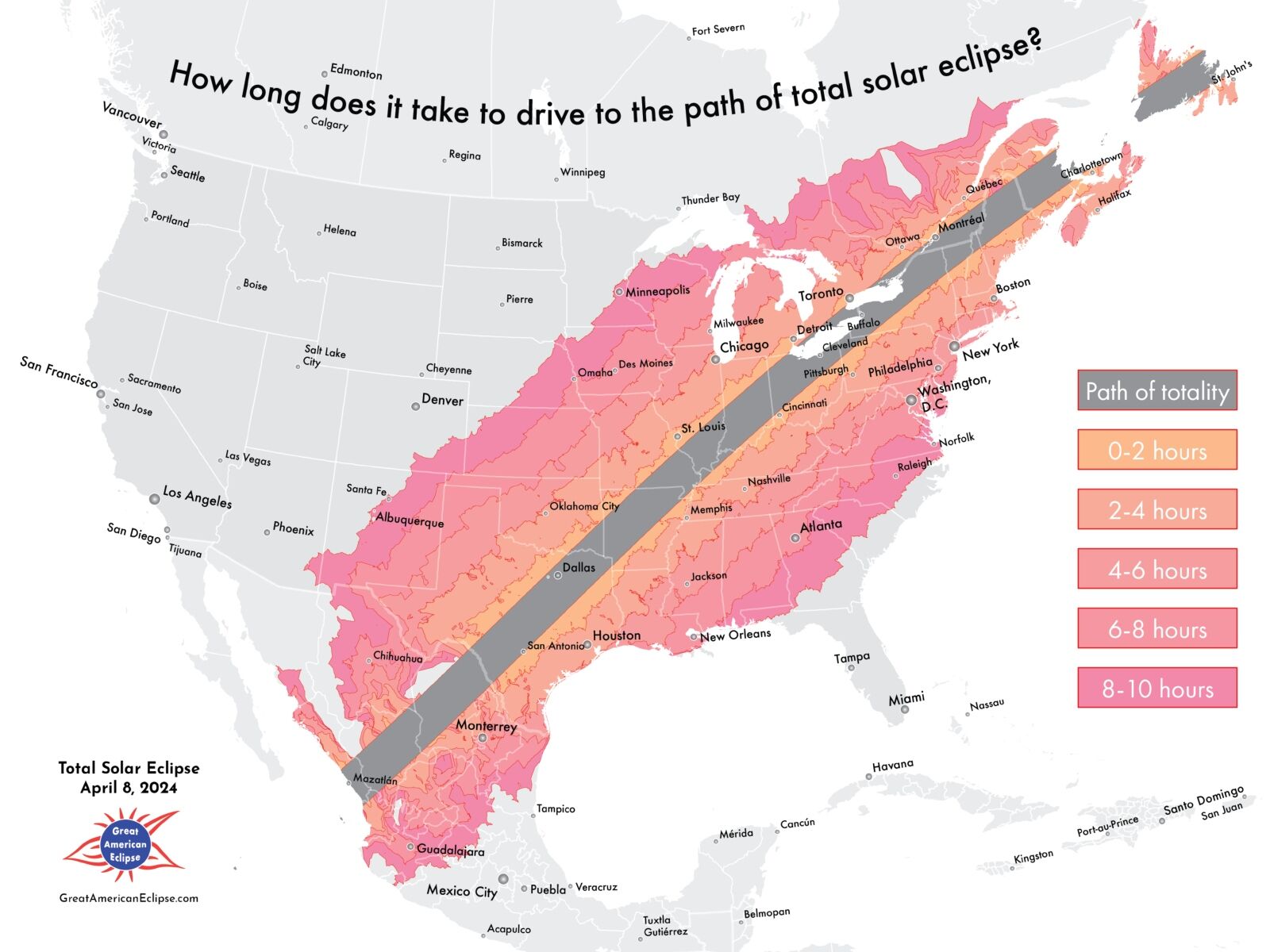
Photo: Great American Eclipse/Michael Zeiler
Viewing the 2024 solar eclipse outside the path of totality won’t allow for the full, breathtaking encounter. Sure, if you’re elsewhere in North America and the weather cooperates, you’ll stand in the shadow of a partial eclipse, when the moon passes in front of just part of the sun. But unless you’re located somewhere on the total eclipse path, the sight won’t be nearly as impressive.
There’s no mystery as to where and when you’ll be able to see the total solar eclipse in the United States. The eclipse will occur in parts of the following states:
- Texas
- Oklahoma
- Arkansas
- Missouri
- Kentucky
- Illinois
- Indiana
- Ohio
- Pennsylvania
- New York
- Vermont
- New Hampshire
- Maine
Tiny slivers of Tennessee and Michigan are also on the path of totality, but they’re often omitted from state lists because the areas are so small.
US cities on the eclipse path include:
- Austin, Texas
- Dallas, Texas
- Fort Worth, Texas
- Little Rock, Arkansas
- Indianapolis, Indian
- Dayton, Ohio
- Cleveland, Ohio
- Buffalo, New York
- Rochester, New York
- Syracuse, New York
- Burlington, Vermont
At any point along the path, scientists know down to the second when the moon will begin to pass in front of the sun (partial eclipse), how long the moon will fully cover the sun (totality), and when the sun will no longer be covered by the moon.
NASA spells out a few timetable examples rounded to the minute. For instance, in Dallas, the partial eclipse will begin at 12:23 PM CDT, totality occurs between 1:40 and 1:44 PM, and the moon will finish passing in front of the sun at 3:02 PM. In Caribou, Maine, the partial eclipse starts at 2:22 PM EDT, totality lasts just two minutes between 3:32 and 3:34 PM, and the show is over at 4:40 PM.
The closer a viewing spot is to the path’s center, the longer totality occurs. You can find the center along the blue line on this helpful interactive Google map created by Xavier M. Jubier.
Best places to see the total solar eclipse 2024
Cloudless skies are key for viewing a total solar eclipse. “Texas will be the favored destination for most eclipse chasers because this state offers the best odds of clear weather on eclipse day,” Zeiler says. Jay Anderson, who shares historical climate data at Ecipsophile, gets even more specific: “According to the satellite data, the best climatological prospects lie between Junction and Brady, both in Texas.”
Ideally, you’re situated outdoors in a wide, open space with few buildings or large trees that might block your view of the sky. No matter where you plan to be on April 8, if you have your heart set on fully experiencing a total solar eclipse, you’ll need to be flexible. “Our advice is to stack your odds by paying attention to short-term weather forecasts, and if poor weather is forecast, jump in your car very early on eclipse day (or the evening before),” Zeiler says.
Consider what roads will allow you to move quickly to a new viewing spot. For example, Zeiler plans to be in Fredericksburg, Texas, with his family. “The Texas Hill Country has reasonably good weather prospects, and if the weather forces relocation, Fredericksburg is at the junction of six highways.”
Total solar eclipse 2024 community events and travel packages
From the Pacific to the North Atlantic oceans, and in tiny towns and major metropolises, opportunities to celebrate the eclipse along the path of totality are numerous. Unsurprisingly, hotels on the route have jacked up room rates, minimum multi-night stays are in place, and availability is already slim. If you haven’t confirmed accommodations yet, make your plans now.
Here’s just a sampling of ways to mark the event along the path:
- Cleveland’s NASA Glenn Visitors Center at the Great Lakes Science Center is hosting a three-day Total Eclipse Festival, and has astronomy related attractions like a newly renovated planetarium and observatory at the Museum of Natural History and free access to the International Woman’s Air and Space Museum.
- Holland America Line’s 22-day Solar Eclipse & Circle Hawaii cruise from San Diego to Vancouver still has staterooms available at time of publication.
- More than two dozen Texas state parks will be open to visitors with a day pass or camping permit.
- The Mid-America Science Museum in Hot Springs, Arkansas, has scheduled a family-friendly viewing event with a picnic lunch.
- Southern Illinois University in Carbondale is holding Eclipse Day at Saluki Stadium.
- NASA is partnering with the International Motor Speedway in Indianapolis for a full day of programming.
- Sheraton Niagara Falls has a two-night stay starting at $899 per night.
- Vermont’s Jay Peak Resort is offering chair-lift rides to the ski mountain’s summit for prime eclipse viewing and lodging packages with eclipse swag.
Gear for watching the solar eclipse 2024 and other tips
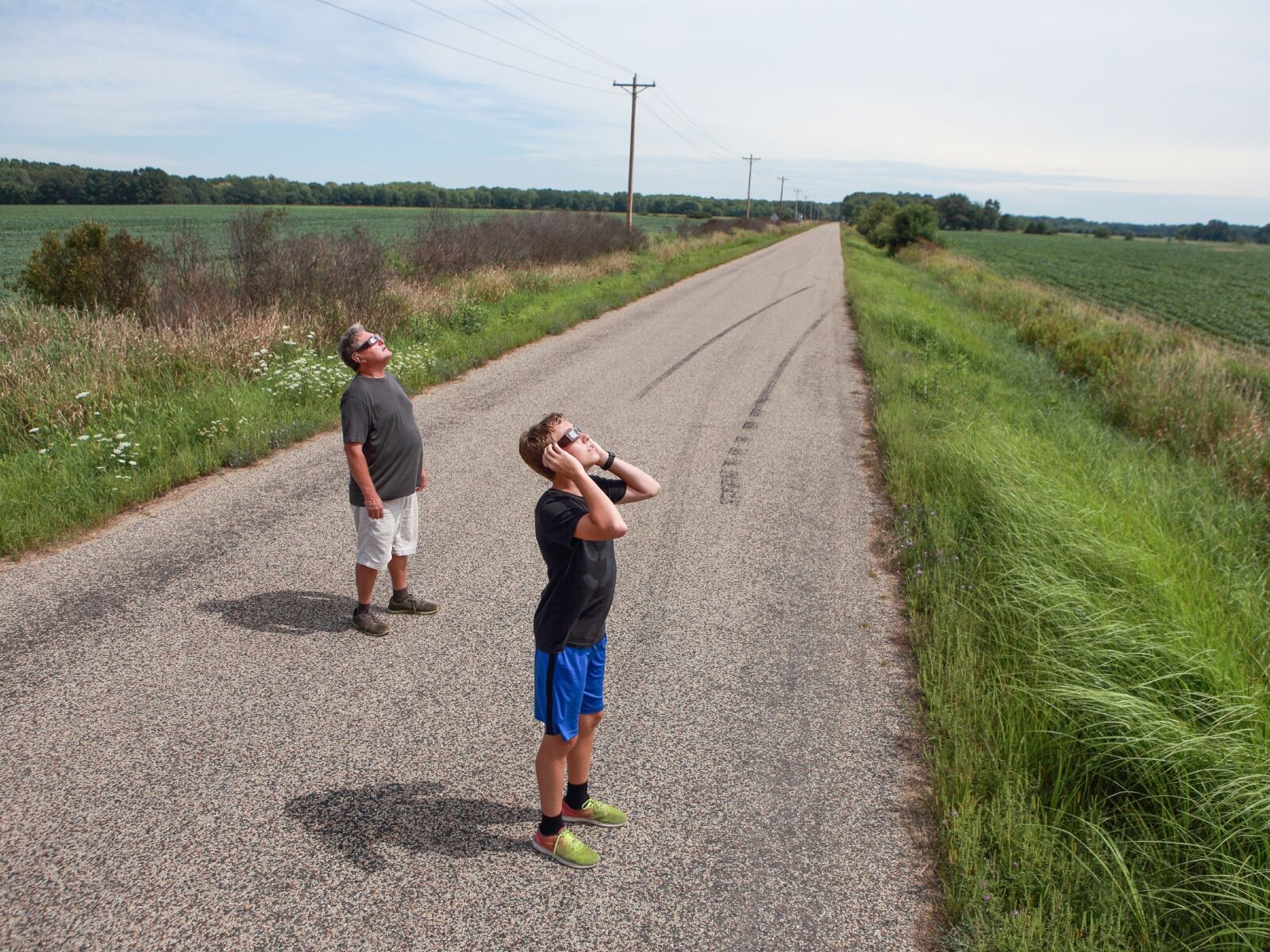
Photo: Suzanne Tucker/Shutterstock
Solar filters (eclipse glasses or handheld solar viewers) are key for looking at the sun during an eclipse. Otherwise, you could irreversibly damage your eyes. The only time you can look directly at the eclipse without protective eyewear is if you’re inside the path of totality and the moon is completely covering the sun with just the corona visible. The moment the moon begins to move away from the sun, you’ll need to put your special eclipse glasses back on.
Solar filters for telescopes, cameras, and smartphone lenses are also available. However, I’d leave photography to the experts and just admire the awe-inspiring scene without trying to capture the perfect image. Another pro tip: Don’t bother with a pinhole viewer and buy the glasses or check with your local library for freebies.
Also, make your viewing plans with potential safe backup spots in mind. Yes, you want to be flexible if the weather goes south, but preferably you’re settled in place well before the partial eclipse begins. Operating a vehicle and searching the sky don’t pair well.
My family and I got lucky during the 2017 total solar eclipse when law enforcement didn’t shoo us off a Wyoming exit ramp. (Not that anyone could have effectively ticketed hundreds of cars parked illegally just off the interstate.) For the 2024 eclipse, we plan to be in Waco, Texas, standing with friends in a wide-open spot well before the show is scheduled to start. It’s likely we’ll have a glass of prosecco in hand, ready to toast Mother Nature in all her brilliance. Then we’ll start making plans for viewing our next celestial wonder. Northern Spain in 2026, anyone?